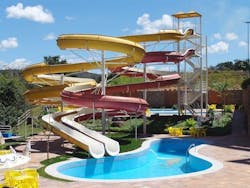Pool Purification
As winter becomes nothing more than a memory and the days get warmer, our thoughts are quickly turning to the lazy, hazy days of summer. And nothing is more refreshing on a hot summer day than a dip in the pool.
Most people take pool water safety for granted, whether they are at a public pool, a friend’s house or in their own backyards — and usually they are right to do so. But swimmers introduce all sorts of organic contaminants to the water, such as bacteria, urine, sweat and saliva. The very thought of swimming in water containing all those bodily secretions is enough to turn many people off the idea of swimming pools. That is why pool water must undergo treatment — to keep it safe and clean for swimmers and free from harmful substances like bacteria, viruses and algae.
For most pool owners, chlorine has traditionally been the disinfectant of choice. Sweat and urine, however, largely consist of water, ammonia and urea. When these products react with chlorine, unwanted byproducts can form, consisting mainly of chloramines, which, along with chlorinated organic compounds, are known to create swimming pool odor and cause eye, nose and throat irritation.
Additional disinfection challenges include chlorine-resistant microorganisms, poor maintenance, poor hygiene, increased numbers of swimmers (many of whom are young children, which can result in increased diarrhea and/or normal fecal accidents) and water swallowing. All of these factors increase the risk of waterborne illness outbreaks.
There also are some common disease-causing microorganisms, such as Cryptosporidium, that are resistant to chlorine disinfection and can survive for days in chlorine-treated swimming pools. The popularity of pools, the number and geographic distribution of recent cryptosporidiosis outbreaks, and the resistance of Cryptosporidium to chlorination clearly suggest that swimming pool water treatment needs to be improved.
UV Benefits
Ultraviolet (UV) treatment is a chemical-free way to purify water and deactivate harmful microbes. It is a powerful, effective technology that has been successfully deployed in swimming pools for years.
UV disinfection of pools is a complementary way of providing an effective method of inactivating a wide range of waterborne pathogens, including Cryptosporidium. It also can significantly reduce microbial counts by destroying at least 99.99% of the bacteria present in the influent stream when installed after filtration. UV water treatment disinfects and simultaneously reduces chloramines and chloro-organics as water passes through the treatment chamber.
The use of UV disinfection for pools is particularly suitable if swimmers are sensitive or allergic to the usual swimming pool disinfectants, such as chlorine. UV is not designed to completely replace chlorine, but through an elimination of the need for periodic “shocking,” well-maintained pools can see significant reductions in chlorine usage.
UV inactivates a host of pathogenic microorganisms, including bacteria, viruses and protozoans (such as Cryptosporidium and Giardia) at low doses. It also is effective for breaking down chloramine compounds, the culprit associated with swimming pool odor and eye, nose and throat irritation.
Benefits of UV disinfection include:
- More pleasant swimming in a low-chemical environment;
- Reduced chemical dosing (50% or more) and chemical costs;
- Possibility of zero-chlorine bathing using peroxide disinfectants;
- Protection against contamination in swimming pool filter media;
- Safety net protection against loss of chemical dosing;
- Instantaneous water disinfection at every pass;
- Low power consumption; and
- Low purchase and running costs.
Sizing the UV System
A properly sized UV system is designed to meet a minimum of 3-log reduction of pathogenic microorganisms. To determine the best system for your swimming pool, you must first:
- 1. Calculate the volume of the pool (Example: 24,000 gal).
- 2. Determine the turnover time of the pool (Example: A 24,000-gal pool turnover of approximately four hours).
- 3. Divide the total gallons of water by the turnover time in hours to get the number of gallons per hour (Example: 24,000 ÷ 4 = 6,000 gal per hour [gph]).
- 4. Divide the gallons per hour by 60 minutes to determine the gallons-per-minute calculation (Example: 6,000 gph ÷ 60 minutes = 100 gal per minute).
Swimming pool applications generally employ a 60-mJ-per-sq-cm UV dose. You may need to consider two UV disinfection systems installed in parallel in order to achieve optimal performance.
A typical installation of UV equipment would happen post-filter, ahead of any chemical injection equipment.
Summary
Treating swimming pool water with UV effectively eliminates microbiological contamination and reduces the level of chloramines in the pool. While UV purification has the added benefit of accomplishing disinfection in swimming pools, it should not be considered a replacement for chlorination or other types of chemical treatment. A properly sized UV system successfully controls chloramines, increases comfort and health for swimmers, eliminates the need for dilution and super chlorination, reduces corrosion and, most importantly, protects against Cryptosporidium and Giardia.
As a water treatment dealer or a company dealing with water treatment equipment, there is tremendous opportunity in residential swimming pool applications. The knowledge of what is needed for safe, clean water is the only tool you need.
Download: Here
